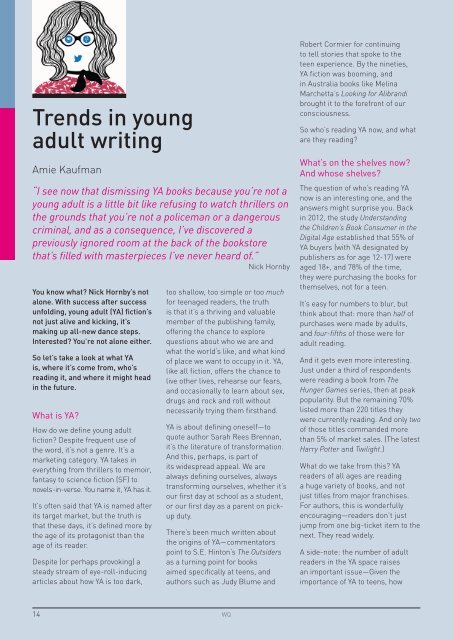Kristina Olsson
?r=MTAwMA0KDQoNCmM2ZDAwMDAwMDAwNjYwOQ0KaHR0cDovL3d3dy5xd2MuYXNuLmF1L2Fzc2V0cy9maWxlcy9XUU1hZ2F6aW5lL1dRJTIwSXNzdWUlMjAyNTUlMjAtJTIwZmluYWwucGRmDQp0cnVlDQptZWxpc3NhY3JhaWdhdXRob3JAZ21haWwuY29t
?r=MTAwMA0KDQoNCmM2ZDAwMDAwMDAwNjYwOQ0KaHR0cDovL3d3dy5xd2MuYXNuLmF1L2Fzc2V0cy9maWxlcy9XUU1hZ2F6aW5lL1dRJTIwSXNzdWUlMjAyNTUlMjAtJTIwZmluYWwucGRmDQp0cnVlDQptZWxpc3NhY3JhaWdhdXRob3JAZ21haWwuY29t
Create successful ePaper yourself
Turn your PDF publications into a flip-book with our unique Google optimized e-Paper software.
Trends in young<br />
adult writing<br />
Amie Kaufman<br />
“I see now that dismissing YA books because you’re not a<br />
young adult is a little bit like refusing to watch thrillers on<br />
the grounds that you’re not a policeman or a dangerous<br />
criminal, and as a consequence, I’ve discovered a<br />
previously ignored room at the back of the bookstore<br />
that’s filled with masterpieces I’ve never heard of.”<br />
Nick Hornby<br />
You know what? Nick Hornby’s not<br />
alone. With success after success<br />
unfolding, young adult (YA) fiction’s<br />
not just alive and kicking, it’s<br />
making up all-new dance steps.<br />
Interested? You’re not alone either.<br />
So let’s take a look at what YA<br />
is, where it’s come from, who’s<br />
reading it, and where it might head<br />
in the future.<br />
What is YA?<br />
How do we define young adult<br />
fiction? Despite frequent use of<br />
the word, it’s not a genre. It’s a<br />
marketing category. YA takes in<br />
everything from thrillers to memoir,<br />
fantasy to science fiction (SF) to<br />
novels-in-verse. You name it, YA has it.<br />
It’s often said that YA is named after<br />
its target market, but the truth is<br />
that these days, it’s defined more by<br />
the age of its protagonist than the<br />
age of its reader.<br />
Despite (or perhaps provoking) a<br />
steady stream of eye-roll-inducing<br />
articles about how YA is too dark,<br />
too shallow, too simple or too much<br />
for teenaged readers, the truth<br />
is that it’s a thriving and valuable<br />
member of the publishing family,<br />
offering the chance to explore<br />
questions about who we are and<br />
what the world’s like, and what kind<br />
of place we want to occupy in it. YA,<br />
like all fiction, offers the chance to<br />
live other lives, rehearse our fears,<br />
and occasionally to learn about sex,<br />
drugs and rock and roll without<br />
necessarily trying them firsthand.<br />
YA is about defining oneself—to<br />
quote author Sarah Rees Brennan,<br />
it’s the literature of transformation.<br />
And this, perhaps, is part of<br />
its widespread appeal. We are<br />
always defining ourselves, always<br />
transforming ourselves, whether it’s<br />
our first day at school as a student,<br />
or our first day as a parent on pickup<br />
duty.<br />
There’s been much written about<br />
the origins of YA—commentators<br />
point to S.E. Hinton’s The Outsiders<br />
as a turning point for books<br />
aimed specifically at teens, and<br />
authors such as Judy Blume and<br />
Robert Cormier for continuing<br />
to tell stories that spoke to the<br />
teen experience. By the nineties,<br />
YA fiction was booming, and<br />
in Australia books like Melina<br />
Marchetta’s Looking for Alibrandi<br />
brought it to the forefront of our<br />
consciousness.<br />
So who’s reading YA now, and what<br />
are they reading?<br />
What’s on the shelves now?<br />
And whose shelves?<br />
The question of who’s reading YA<br />
now is an interesting one, and the<br />
answers might surprise you. Back<br />
in 2012, the study Understanding<br />
the Children’s Book Consumer in the<br />
Digital Age established that 55% of<br />
YA buyers (with YA designated by<br />
publishers as for age 12-17) were<br />
aged 18+, and 78% of the time,<br />
they were purchasing the books for<br />
themselves, not for a teen.<br />
It’s easy for numbers to blur, but<br />
think about that: more than half of<br />
purchases were made by adults,<br />
and four-fifths of those were for<br />
adult reading.<br />
And it gets even more interesting.<br />
Just under a third of respondents<br />
were reading a book from The<br />
Hunger Games series, then at peak<br />
popularity. But the remaining 70%<br />
listed more than 220 titles they<br />
were currently reading. And only two<br />
of those titles commanded more<br />
than 5% of market sales. (The latest<br />
Harry Potter and Twilight.)<br />
What do we take from this? YA<br />
readers of all ages are reading<br />
a huge variety of books, and not<br />
just titles from major franchises.<br />
For authors, this is wonderfully<br />
encouraging—readers don’t just<br />
jump from one big-ticket item to the<br />
next. They read widely.<br />
A side-note: the number of adult<br />
readers in the YA space raises<br />
an important issue—Given the<br />
importance of YA to teens, how<br />
14<br />
WQ


